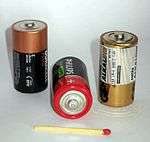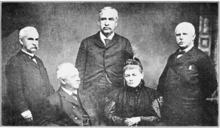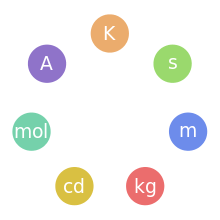Volt
| Volt | |
|---|---|
|
Josephson junction array chip developed by the National Bureau of Standards as a standard volt | |
| Unit information | |
| Unit system | SI derived unit |
| Unit of | Electric potential, electromotive force |
| Symbol | V |
| Named after | Alessandro Volta |
| In SI base units: | kg·m2·s−3·A−1 |
The volt (symbol: V) is the derived unit for electric potential, electric potential difference (voltage), and electromotive force.[1] The volt is named in honour of the Italian physicist Alessandro Volta (1745–1827), who invented the voltaic pile, possibly the first chemical battery.
Definition
One volt is defined as the difference in electric potential between two points of a conducting wire when an electric current of one ampere dissipates one watt of power between those points.[2] It is also equal to the potential difference between two parallel, infinite planes spaced 1 meter apart that create an electric field of 1 newton per coulomb. Additionally, it is the potential difference between two points that will impart one joule of energy per coulomb of charge that passes through it. It can be expressed in terms of SI base units (m, kg, s, and A) as
It can also be expressed as amperes times ohms (current times resistance, Ohm's law), watts per ampere (power per unit current, Joule's law), or joules per coulomb (energy per unit charge), which is also equivalent to electron-volts per elementary charge:
Josephson junction definition
The "conventional" volt, V90, defined in 1988 by the 18th General Conference on Weights and Measures and in use from 1990, is implemented using the Josephson effect for exact frequency-to-voltage conversion, combined with the caesium frequency standard. For the Josephson constant, KJ = 2e/h (where e is the elementary charge and h is the Planck constant), the "conventional" value KJ-90 is used:
This standard is typically realized using a series-connected array of several thousand or tens of thousands of junctions, excited by microwave signals between 10 and 80 GHz (depending on the array design).[3] Empirically, several experiments have shown that the method is independent of device design, material, measurement setup, etc., and no correction terms are required in a practical implementation.[4]
Water-flow analogy
In the water-flow analogy sometimes used to explain electric circuits by comparing them with water-filled pipes, voltage (difference in electric potential) is likened to difference in water pressure.
The relationship between voltage and current is defined (in ohmic devices like resistors) by Ohm's Law. Ohm's Law is analogous to the Hagen–Poiseuille equation, as both are linear models relating flux and potential in their respective systems.
Common voltages


The voltage produced by each electrochemical cell in a battery is determined by the chemistry of that cell. Cells can be combined in series for multiples of that voltage, or additional circuitry added to adjust the voltage to a different level. Mechanical generators can usually be constructed to any voltage in a range of feasibility.
Nominal voltages of familiar sources:
- Nerve cell resting potential: around −75 mV[5]
- Single-cell, rechargeable NiMH[6] or NiCd battery: 1.2 V
- Single-cell, non-rechargeable (e.g., AAA, AA, C and D cells): alkaline battery: 1.5 V; zinc-carbon battery: 1.56 V if fresh and unused
- LiFePO4 rechargeable battery: 3.3 V
- Lithium polymer rechargeable battery: 3.75 V (see Rechargeable battery#Table of rechargeable battery technologies)
- Transistor-transistor logic/CMOS (TTL) power supply: 5 V
- USB: 5 V DC
- PP3 battery: 9 V
- Internal Combustion Automobile electrical system: nominal 12 V, about 11.8 V discharged, 12.8 V charged, and 13.8–14.4 V while charging (vehicle running).
- Electric Car Battery: 400 V when fully charged[7]
- Trucks/lorries: 24 V DC (Europe), 12 V DC (North America)
- Household mains electricity AC: (see List of countries with mains power plugs, voltages and frequencies)
- 100 V in Japan
- 120 V in North America,
- 230 V in Europe, Asia and Africa,
- Rapid transit third rail: 600–750 V (see List of current systems for electric rail traction)
- High-speed train overhead power lines: 25 kV at 50 Hz, but see the list of current systems for electric rail traction and 25 kV at 60 Hz for exceptions.
- High-voltage electric power transmission lines: 110 kV and up (1.15 MV was the record as of 2005)
- Lightning: Varies greatly, often around 100 MV.
History

In 1800, as the result of a professional disagreement over the galvanic response advocated by Luigi Galvani, Alessandro Volta developed the so-called voltaic pile, a forerunner of the battery, which produced a steady electric current. Volta had determined that the most effective pair of dissimilar metals to produce electricity was zinc and silver. In 1861, Latimer Clark and Sir Charles Bright coined the name "volt" for the unit of resistance.[8] By 1873, the British Association for the Advancement of Science had defined the volt, ohm, and farad.[9] In 1881, the International Electrical Congress, now the International Electrotechnical Commission (IEC), approved the volt as the unit for electromotive force.[10] They made the volt equal to 108 cgs units of voltage, the cgs system at the time being the customary system of units in science. They chose such a ratio because the cgs unit of voltage is inconveniently small and one volt in this definition is approximately the emf of a Daniell cell, the standard source of voltage in the telegraph systems of the day.[11] At that time, the volt was defined as the potential difference [i.e., what is nowadays called the "voltage (difference)"] across a conductor when a current of one ampere dissipates one watt of power.

The international volt was defined in 1893 as 1/1.434 of the emf of a Clark cell. This definition was abandoned in 1908 in favor of a definition based on the international ohm and international ampere until the entire set of "reproducible units" was abandoned in 1948.
Prior to the development of the Josephson junction voltage standard, the volt was maintained in national laboratories using specially constructed batteries called standard cells. The United States used a design called the Weston cell from 1905 to 1972.
This SI unit is named after Alessandro Volta. As with every International System of Units (SI) unit named for a person, the first letter of its symbol is upper case (V). However, when an SI unit is spelled out in English, it should always begin with a lower case letter (volt)—except in a situation where any word in that position would be capitalized, such as at the beginning of a sentence or in material using title case. Note that "degree Celsius" conforms to this rule because the "d" is lowercase.— Based on The International System of Units, section 5.2.
See also
References
- ↑ "SI Brochure, Table 3 (Section 2.2.2)". BIPM. 2006. Retrieved 2007-07-29.
- ↑ BIPM SI Brochure: Appendix 1, p. 144
- ↑ Burroughs, Charles J.; Bent, Samuel P.; Harvey, Todd E.; Hamilton, Clark A. (1999-06-01), "1 Volt DC Programmable Josephson Voltage Standard", IEEE Transactions on Applied Superconductivity, Institute of Electrical and Electronics Engineers (IEEE), 9 (3): 4145–4149, doi:10.1109/77.783938, ISSN 1051-8223, retrieved 2014-06-27
- ↑ Keller, Mark W (2008-01-18), "Current status of the quantum metrology triangle" (PDF), Metrologia, 45 (1): 102–109, Bibcode:2008Metro..45..102K, doi:10.1088/0026-1394/45/1/014, ISSN 0026-1394,
Theoretically, there are no current predictions for any correction terms. Empirically, several experiments have shown that KJ and RK are independent of device design, material, measurement setup, etc. This demonstration of universality is consistent with the exactness of the relations, but does not prove it outright.
- ↑ Bullock, Orkand, and Grinnell, pp. 150–151; Junge, pp. 89–90; Schmidt-Nielsen, p. 484
- ↑ Hill, Paul Horowitz; Winfield; Winfield, Hill (2015). The Art of Electronics (3. ed.). Cambridge [u.a.]: Cambridge Univ. Press. p. 689. ISBN 978-0-521-809269.
- ↑ https://www.tesla.com/sites/default/files/downloads/20130214_ModelS_Emergency_Response_Guide.pdf
- ↑ As names for units of various electrical quantities, Bright and Clark suggested "ohma" for voltage, "farad" for charge, "galvat" for current, and "volt" for resistance. See:
- Latimer Clark and Sir Charles Bright (1861) "On the formation of standards of electrical quantity and resistance," Report of the Thirty-first Meeting of the British Association for the Advancement of Science (Manchester, England: September 1861), section: Mathematics and Physics, pp. 37-38.
- Latimer Clark and Sir Charles Bright (November 9, 1861) "Measurement of electrical quantities and resistance," The Electrician, 1 (1) : 3–4.
- ↑ Sir W. Thomson, et al. (1873) "First report of the Committee for the Selection and Nomenclature of Dynamical and Electrical Units," Report of the 43rd Meeting of the British Association for the Advancement of Science (Bradford, September 1873), pp. 222-225. From p. 223: "The "ohm," as represented by the original standard coil, is approximately 109 C.G.S. units of resistance ; the "volt" is approximately 108 C.G.S. units of electromotive force ; and the "farad" is approximately 1/109 of the C.G.S. unit of capacity."
- ↑ (Anon.) (September 24, 1881) "The Electrical Congress," The Electrician, 7 : 297.
- ↑ Hamer, Walter J. (January 15, 1965). Standard Cells: Their Construction, Maintenance, and Characteristics (PDF). National Bureau of Standards Monograph #84. US National Bureau of Standards.
External links
| Look up volt in Wiktionary, the free dictionary. |

